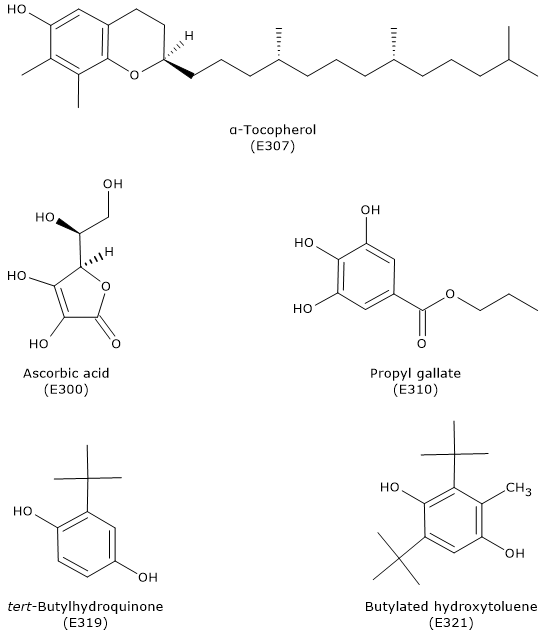Antioxidants, when used as food additives, are molecules that prevent or slow down oxidation during the transport, storage, and processing of food.[1][2]
Food oxidation occurs as a result of exposure to atmospheric oxygen, light, and heat. This leads to the alteration or destruction of molecules that, because of their chemical structure, are particularly sensitive to oxidative damage. As a result, the organoleptic properties, such as colour, flavour, and texture, along with the nutritional value, may be reduced.[3][4]
The most commonly used antioxidants are organic compounds such as phenols, aromatic amines, and aminophenols.[5]
Like other food additives, antioxidants are identified by the E-numbering system, where “E” stands for Europe, alongside their chemical name.[6]
Like most food additives, antioxidants are considered safe for human health when used in accordance with specific guidelines.[7]
Contents
- How antioxidants work
- Natural and synthetic antioxidants
- Examples of antioxidants
- Health effects
- References
How antioxidants work
Antioxidants prevent or slow down oxidation. The main antioxidant mechanisms include:
- free radical scavenging;
- removal of peroxides and other reactive oxygen species;
- quenching of secondary lipid oxidation products, which can produce rancid odours;
- chelation of metals.[4]
Molecules that are highly sensitive to oxidative damage include unsaturated fatty acids, both monounsaturated and polyunsaturated, vitamins, and various amino acids. Unsaturated fatty acids occur in the form of triglycerides in cooking oils and fats, such as olive oil, butter, and margarine. Their oxidation contributes to the development of rancidity in these products.[8][9]
Antioxidants also help prevent the formation of molecules that may be harmful to health, a function similar to that of preservatives.[10]
Natural and synthetic antioxidants
Antioxidants are chemically reducing agents.
They can be of natural origin, such as vitamin C (E300) and α-tocopherol (E307), or synthetic, such as gallates, esters of ascorbic acid with fatty acids (E304), erythorbic acid (E315), or tert-butylhydroquinone (E319) and butylated hydroxytoluene (E321).
It should be noted that erythorbic acid is the D-isomer of vitamin C, with low vitamin activity.[3]

However, the distinction between synthetic and naturally occurring antioxidants can be misleading, since both vitamin C and tocopherols are often produced synthetically, as their high demand cannot be met by natural sources alone.[9]
Examples of antioxidants
The following is an overview of antioxidants included in the list of food additives approved in the European Union under Commission Regulation 1129/2011, published on November 11, 2011. This regulation amended Annex II to Regulation (EC) No. 1333/2008 of the European Parliament, and was itself further amended in 2013.[11]
| E-number | Additive and derivatives |
|---|---|
| Vitamin C or ascorbic acid | |
| E300 | Ascorbic acid |
| E301 | Sodium ascorbate |
| E302 | Calcium ascorbate |
| E304 | Esters of ascorbic acid with fatty acids |
| Tocopherols | |
| E306 | Tocopherol-rich extract |
| E307 | α-Tocopherol |
| E308 | γ-Tocopherol |
| E309 | δ-Tocopherol |
| Gallates and other antioxidants | |
| E310 | Propyl gallate |
| E311 | Octyl gallate |
| E312 | Dodecyl gallate |
| E315 | Erythorbic acid |
| E316 | Sodium erythorbate |
| E319 | tert-Butylhydroquinone |
| E320 | Butylated hydroxyanisole |
| E321 | Butylated hydroxytoluene |
Health effects
As with other food additives, the safety of antioxidants is evaluated by the relevant authorities based on the latest available scientific research. Scientific evidence shows that, when used within established guidelines, antioxidants pose no health risks. Nonetheless, these additives are regularly reassessed to ensure ongoing compliance with health standards.[12]
References
- ^ Bender D.A. Benders’ dictionary of nutrition and food technology. 8th ed. Woodhead Publishing. Oxford, 2006.
- ^ Food Standards Agency. Food additives. Last updated: 16 July 2025. https://www.food.gov.uk/safety-hygiene/food-additives
- ^ a b Belitz H.-D., Grosch W., Schieberle P. Food Chemistry. 4th Edition. Springer, 2009.
- ^ a b Hui Y.H., Sherkat F. Handbook of food science, technology, and engineering – 4 volume set. 1st Edition. 2005. CRC Press. doi:10.1201/b15995
- ^ Britannica, The Editors of Encyclopaedia. Antioxidant. Encyclopedia Britannica, 12 July 2025. Accessed 19 August 2025.
- ^ Food Standards Agency. Approved additives and E Numbers. Last updated: 16 July 2025.
- ^ EFSA Panel on Food Additives and Nutrient Sources added to Food (ANS); Guidance for submission for food additive evaluations. EFSA Journal 2012;10(7):2760. [53 pp.] doi:10.2903/j.efsa.2012.2760. Available online: www.efsa.europa.eu/efsajournal
- ^ Akoh C.C., Min D.B. Food lipids: chemistry, nutrition, and biotechnology. 4th Edition. 2017. doi:10.1201/9781315151854
- ^ a b Damodaran S., Parkin K. Fennema’s Food Chemistry. 5th Edition. CRC Press, 2017.doi:10.1201/9781315372914
- ^ García-García R., Searle S.S. Preservatives: food use. Encyclopedia of Food and Health. 2016:505-509. doi:10.1016/B978-0-12-384947-2.00568-7
- ^ Commission Regulation (EU) No 1129/2011 of 11 November 2011 amending Annex II to Regulation (EC) No 1333/2008 of the European Parliament and of the Council by establishing a Union list of food additives. https://eur-lex.europa.eu/eli/reg/2011/1129/2013-11-21
- ^ EFSA Panel on Food Additives and Nutrient Sources added to Food (ANS); Younes M., Aggett P., Aguilar F., et al. Guidance on safety evaluation of sources of nutrients and bioavailability of nutrient from the sources. EFSA J 2018;16(6):e05294. doi:10.2903/j.efsa.2018.5294